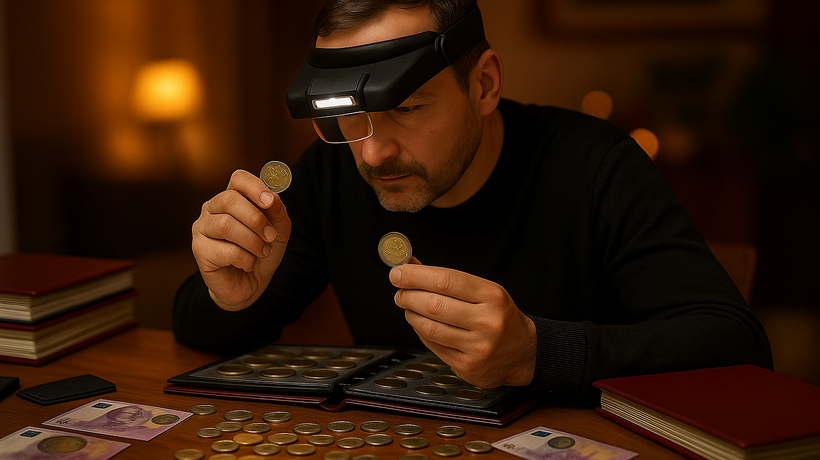In Slovakia, it has been possible to pay with the euro for 15 years. Besides the fact that when traveling to European Union countries, we no longer have to exchange Slovak crowns for euros, it has opened up the possibility for coin collectors to collect circulating and commemorative euro coins from eurozone countries. Commemorative 2-euro coins are relatively easily accessible, which is why they are very popular in numismatics.
Euro coins are made of two parts – an inner part of nickel brass and an outer part of copper and nickel. The combination of two alloys has earned them the designation of bimetallic coins – composed of two metals.
From 2004 to 2014, each country had the right to issue one of its own commemorative euro coins. Commemorative euro coins common to all EU countries (except for the name of the country itself) were issued in 2007, 2009, 2012, 2015, and 2022. They commemorate important anniversaries and milestones associated with the EU and its values. After 2015, the rules were adjusted, and each country can issue two commemorative 2€ coins per year according to the proposal of the national bank of the given country.
Why do some 2-euro coins become rare?
The reasons can be varied. The first factor is their limited mintage or distribution. Another important factor is errors in minting or design, which can be desirable from a numismatic point of view.
The most interesting countries and their 2€ commemorative coins
In the EU, there are several countries that issue interesting and often valuable 2-euro coins:
- Andorran 2€ coins
Commemorative coins are issued exclusively in the form of coincards, whose issue price is higher than 2 €. Andorra issues two commemorative coins each year, which are highly sought after by euro coin collectors. - Vatican 2€ coins
The Vatican is known for issuing rare coins with papal portraits or religious motifs. Most of these coins are sold only in official sets and do not enter regular circulation, increasing their collector's value. - Monaco 2€ coins
Monaco issues highly sought-after commemorative coins. Exceptionally rare is the 2-euro Grace Kelly coin from 2007, minted in a quantity of only 20,001 pieces. These coins are among the rarest euro coins on the market. - Finnish 2€ coins
Finland is known for national motifs and symbols of nature on its commemorative coins. It issued its first commemorative coin in 2004 to commemorate the enlargement of the European Union, which Slovakia also joined at that time. - Among the interesting ones are also 2-euro coins from San Marino and Luxembourg, which are sought after by investment collectors.
On the other hand, less valuable euro coins include those from Germany, which, although depicting significant German cities, each motif is issued in a high mintage of around 30 million pieces. The same applies to Slovak 2-euro coins, which have been issued since 2009 in a mintage of 1 million pieces. Collectible are especially the proof coins of Slovakia, which are sold in special boxes "etue" and do not enter circulation. All these euro coins have not only financial value but also cultural and historical significance, making them popular among numismatists and coin collectors worldwide.
0€ souvenirs: A collector's phenomenon of recent years
The concept of 0€ souvenirs originated in France in 2015 and reached Slovakia in 2018. Since their inception, they have sparked a wave of enthusiasm among banknote collectors. In several places, collectors stood in long lines to obtain limited editions of euro souvenirs with selected serial numbers, making each euro souvenir unique. Collectors seek numbers with significance – for example, birth dates, repeating numbers (e.g., 333), or low serial numbers below 100.
0 euro souvenirs are not only a beautiful memento of a specific place, personality, or historical event but also a work of art. Renowned artists such as Matej Gabriš and Adrian Ferda are involved in their design. They are printed on the same paper and in the same printing houses as real euro banknotes, but they cannot be used for payment.
These souvenirs with zero value are often issued in limited series, making them attractive pieces for collectors of 0€ banknotes. Among the rarest are, for example:
- The first Slovak 0€ banknote issued by the SNP Museum with the motif of the SNP memorial and the Lt.38 tank.
- Bratislava 0€ banknote with a text error "Bratislavký," which is highly valued among collectors.
0€ souvenirs quickly became popular in Slovakia as well. Their beautiful design and detailed craftsmanship often reflect the culture, history, or architecture of specific places. They represent an ideal memento from travels and also become a beautiful gift or memory for friends and family. On Slovak 0€ souvenirs, we find motifs of famous places, castles, personalities, and various other interesting themes, increasing their collectible and investment value.
